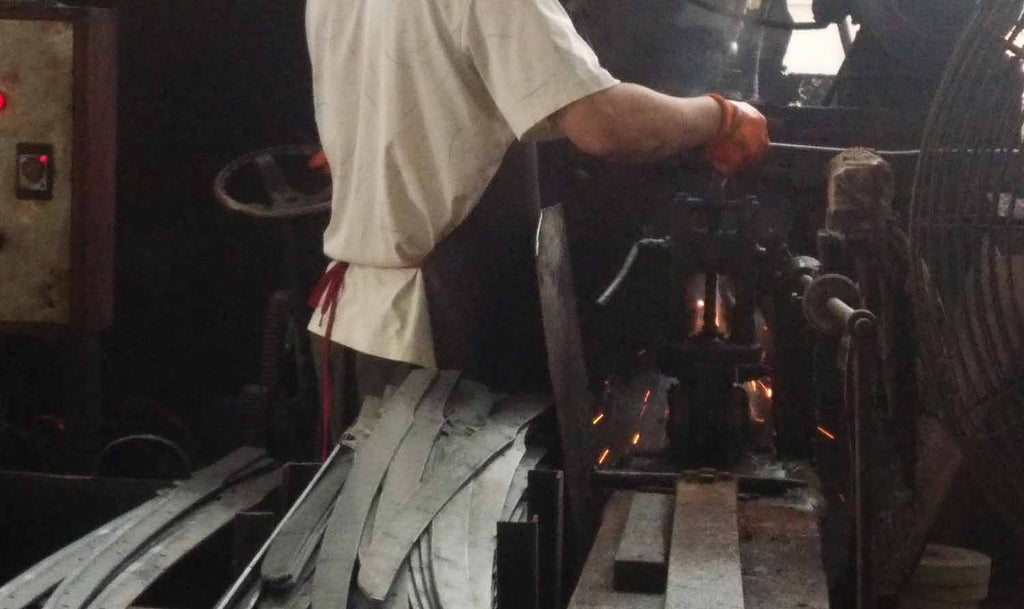What are Japanese swords?
Simply put, Japanese swords or katana are made by a unique Japanese blacksmithing method and are assumed to have been crafted in Japan, but a Japanese sword cannot merely be characterized as a weapon. It has been for long a symbol of the authority of both emperors and warriors and sometimes an object of faith. Today, the Japanese sword is widely considered as an art piece: many are internationally considered cultural assets, some are even officially defined as national treasures in Japan.

The Big Factory
We have heard more and more of products informally named katanas being manufactured outside of Japan, but due to the Japanese Firearms Law preventing their importation into the territory, much about the items remained all but a mystery to us within Japan. On a recent trip abroad, we were given the opportunity to visit one such factory where “katanas” are being manufactured.

Our initial impression was quite simply surprising due to the factory’s size and scale. The image of major electronics or automobile manufacturers came to mind. This made us wonder just how much of a demand for these katanas there must be around the world.

The production of these katanas is done by manufacturing each part in a different factory and then assembling each part at the end. We first visited the factory where the sword blades are manufactured. Compared to a Japanese swordsmith's workshop, the large-scale equipment that was used to manufacture swords was unimaginably large and occupied a lot of space.

The sight of many piles of long, thin plates made of steel before being formed was a far cry from the scene of Japanese sword smiths praying to the gods before forging a single blade. From a machine that looked like it was making parts for an engine, sword blades shaped like resembling katana came out one after another.

Workers specializing in sharpening them used grinders to polish each into shape. After sharpening was completed, the sword blades were aligned with the cutting edge facing down. The final polishing of the sword blade was carried out by hand using a towel, a whetstone, and sandpaper.

These completed swords being haphazardly piled up did not seem to receive the same treatment as Japanese swords, which are said to be highly valued as works of art. In another location, metal fittings such as tsuba, fuchi-kashira, and menuki were being pressed. In this factory, other products like model guns were also being cast, but they were not all very precise.

Next to the sword blade factory, we visited a factory that manufactures scabbards. At first glance, there were so many wooden sheaths tied to strings that one could think they were firewood. We asked one of the workers, "What kind of wood are these scabbards made from?" He replied, "I don't know. It doesn't matter what kind of wood it is." This might be true for massively produced items, but I don't think it compares to the magnolia wood used for genuine Japanese swords.

The surface of the exposed wood was still a bit damp. This was surprising as this wood needs to be sufficiently dry before use. The production of the scabbard was done with a fully mechanical cutting process.


The sword handles were also manufactured in the same factory. As with the scabbards, they were being made by machine with an almost frightening number of them piling up on the shelves. In an area not too far, the handle wrapping process was being carried out.

Originally, the handle alone is placed on a special stand to allow for tight, precise wrapping of the cord. Here, surprisingly, they were wrapping the handle with the blade attached. The wrapping process did appear to be done as the wrap on a Japanese sword would be, but upon closer inspection, the alternating twists (known as sashiomote) that would keep the handle from unwinding should the wrap be damaged, were not being carried out, leaving each twist on the same side, and facing the same direction.

Every part of the sword was then assembled and exported to the world in decorative boxes.
Wrapping up
The swordsmiths we are humbled to work with are keepers of traditional knowledge and savoir-faire, beloved by many budoka all over the world. Tozando truly feels enriched today to be a secure link between these incredible craftsmen and our unique and genuine katana-searching patrons.

We can connect sword fans around the world with these wonderful artists and allow them to get close to the reality of the Japanese sword. And this is just what we have set out to do.

Leave a comment: